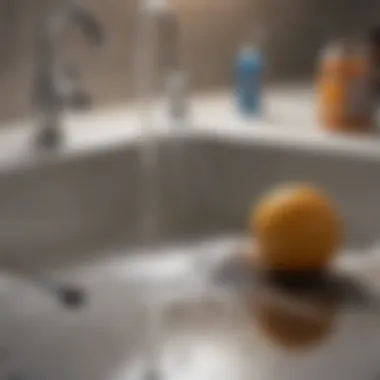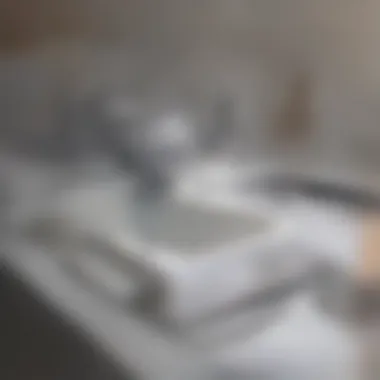Expert Techniques for Clearing Hair from Sink Drains


Intro
In this article, we will delve into diverse methods for both prevention and removal of hair clogs. We will examine practical solutions, tools available on the market, and natural remedies that can mitigate this issue. Understanding the topics addressed here will empower homeowners to maintain better flow and prevent potential plumbing damages.
By acquiring knowledge on effective techniques, individuals can enhance their home maintenance routine and save on costly plumbing repairs. Whether you are a novice or seasoned in home care, this guide aims to provide valuable insights to assist in keeping your drains free from hair and debris.
Understanding the Problem of Hair Clogs
Hair clogs in sink drains are more than just an inconvenience; they can lead to significant plumbing issues if not addressed promptly. The accumulation of hair in a drainage system restricts water flow, which can lead to backups and overflows. Homeowners often overlook this problem until it escalates into a more serious issue requiring professional intervention.
Recognizing the importance of understanding hair clogs is essential for effective home maintenance. Familiarity with this issue allows homeowners to adopt preventative strategies and choose suitable techniques for clearing clogs before they worsen. Awareness of potential pitfalls ensures that individuals prioritize their plumbing health and avoid costly repairs.
The Nature of Hair as a Drain Obstruction
Hair possesses unique properties that make it a persistently troublesome drain obstruction. Its fibrous structure tends to catch soap residue, oils, and other debris, forming dense clumps that inhibit proper drainage. When hair is washed down the sink, it can quickly intertwine with other substances, creating blockages that are not easily removed with simple water flow.
In many cases, hair is not the sole culprit in causing clogs. Instead, it often acts as a catalyst that accelerates the formation of larger clogs. This is why understanding the nature of hair as an obstruction helps to inform cleaning strategies and preventive measures.
Common Causes of Hair Build-Up
Hair build-up in sink drains typically arises from several common habits and circumstances:
- Shampoo and Conditioner Use: Products that leave a film in the drain contribute significantly to hair collection.
- Frequent Hair Washing: Regular hair washing increases the amount of hair entering the drain.
- Lack of Drain Strainers: Not utilizing strainers allows hair to flow freely into the plumbing.
- Poor Ventilation: Humid bathroom conditions may increase the tendency of hair to stick to drain surfaces.
Being aware of these causes helps homeowners take proactive steps to mitigate hair buildup, improving overall drainage health.
Identifying Symptoms of a Clogged Sink Drain
Identifying the symptoms of a clogged sink drain is crucial. Timely recognition can lead to swift action, preventing more severe plumbing issues. When a sink begins to show signs of obstruction, homeowners must pay attention. Ignoring these signs can escalate problems, leading to costly repairs and extensive damage.
Signs of Slow Drainage
One of the most apparent symptoms of a clog is slow drainage. If you notice that water takes longer than usual to empty from your sink, it is a clear indicator. This can occur gradually. You might start to experience a slight delay, which often goes unnoticed initially.
Several factors contribute to slow drainage. Hair is a primary culprit, easily combining with soap residue and other materials. As these build-ups accumulate, they create a barrier in the pipes. The blockage restricts the flow of water. Other signs to look for include:
- Pooling water around the sink.
- Gurgling sounds when the water drains.
- A complete blockage, where water no longer drains.
- Observing multiple sinks draining slowly if they share the same plumbing line.
Noticing these signs early can encourage necessary intervention before the situation worsens.
Unpleasant Odors and Their Indications
Another symptom that often accompanies a clogged sink drain is the presence of unpleasant odors. As organic materials, such as food particles and hair, decompose in the plumbing system, they emit foul smells. This can create an unpleasant environment in your home.
Odors can indicate that a blockage has occurred. When these materials accumulate, they can lead to bacteria growth, which contributes significantly to odors. The best approach is not to ignore a bad smell. Immediate action should be taken to clear the drain. Common indicators include:
- A sour smell, which suggests that food waste is decomposing.
- A musty scent, often linked to mold and bacteria growth in stagnant water.
- A sewer-like odor, indicating a more serious blockage further down the pipes.
Utilizing proper cleaning techniques and identifying these smells is essential for maintaining a healthy drainage system. By recognizing these symptoms of clogged drains, you can safeguard against further complications.
Preventative Measures for Hair Clogs
Preventing hair clogs in sink drains is crucial for maintaining an efficient drainage system. By taking proactive steps, homeowners can significantly reduce the likelihood of experiencing persistent blockages and costly plumbing services. The importance of preventative measures cannot be overstated, as they not only protect the integrity of the plumbing but also promote environmental sustainability by reducing the need for harsh chemicals.
Usage of Drain Strainers
Drain strainers are one of the simplest yet most effective tools to prevent hair from entering drain systems. These devices are designed to catch hair, soap residue, and other debris before they can accumulate in the pipes. Available in various styles, drain strainers can fit over or inside most sink drains, ensuring maximum coverage.


- Installation: Installation is straightforward. Most strainers sit directly in the sink's drain opening or can be integrated with the drainage system. Ensure a snug fit to avoid any gaps where hair could slip through.
- Regular Emptying: To maintain their effectiveness, strainers need to be emptied regularly. After each use, especially when hair styling or grooming, removing collected hair from the strainer ensures it performs optimally.
- Material Considerations: When choosing a strainer, consider durable materials like stainless steel or silicone, which are resistant to rust and easy to clean.
Adopting this simple measure can drastically reduce hair clogs and extend the life of your plumbing system.
Regular Cleaning Practices
Implementing a regular cleaning routine is another vital preventative measure. Enhanced cleaning practices not only contribute to drain health but also allow for the timely identification of potential issues before they escalate.
- Routine Flushes: Regularly flushing the sink with hot water can help dissolve and carry away minor build-ups that accumulate over time, keeping the pipes clear.
- Natural Cleaners: Using natural cleaning agents like vinegar and baking soda can be an effective way to maintain drain cleanliness. Combining these substances creates a fizzing reaction that helps dislodge light clogs. Just pour a half cup of baking soda followed by a half cup of vinegar down the drain, let it sit for about 30 minutes, and then flush with hot water.
- Inspection: Performing an inspection of the sink drain area regularly can help spot any visible signs of hair accumulation around the strainer and drain itself. Early intervention can save significant time and money later.
"An ounce of prevention is worth a pound of cure. Investing time in routine maintenance and easy-to-install solutions can alleviate future plumbing woes."
By committing to these preventative measures, homeowners can maintain a sustainable and efficient plumbing system, ensuring that hair-related issues become a thing of the past.
Tools for Clearing Hair from Sinks
Clearing hair from sink drains requires not only knowledge of the problem but also the right tools to effectively address it. Each tool serves a unique function and can make the process easier and more efficient. Understanding these tools is essential for homeowners and maintenance enthusiasts alike.
Using appropriate tools can significantly reduce the time and effort needed to tackle stubborn clogs, leading to long-term benefits for plumbing health. Selecting the right tool based on the severity and nature of the clog can prevent further issues down the line. Here's a closer look at two commonly used tools in clearing hair clogs in sink drains.
Plumber's Snake Overview
A plumber's snake, also known as a drain auger, is a versatile tool designed to navigate through the twists and turns of a drain system. It consists of a long, flexible metal tube with a coiled or bulbous end. This design allows it to push through obstructions and grab debris, such as tangled hair. The process of using a plumber's snake involves inserting it into the drain and rotating the handle, which helps to break up and retrieve clogs.
Benefits of Using a Plumber's Snake:
- Effective at reaching deeper clogs that are beyond the reach of standard tools.
- Reusable and can be a cost-effective solution for long-term use.
- Minimizes damage to pipes, unlike harsh chemical drain cleaners.
Considerations should be made regarding the type of snake used. There are manual models perfect for small jobs, and powered snakes for larger, more severe clogs. Understanding the limitations of your specific equipment is critical to avoid damaging your plumbing.
Using a Wet/Dry Vacuum
A wet/dry vacuum is a powerful tool that can help in effectively removing hair and other debris from sinks. It works by suctioning up the blockage, making it particularly useful for extracting hair clogs that are relatively loose or shallow. This vacuum type can handle both wet and dry materials, which adds to its versatility in home maintenance.
Steps for Using a Wet/Dry Vacuum to Clear Hair from Sinks:
- Ensure Safety: Unplug the sink and avoid any electrical connections.
- Create a Seal: Fit the vacuum hose into the sink drain opening, ensuring a tight seal.
- Switch On: Turn the vacuum to its highest setting and allow it to run for a few moments.
- Inspect: Check if any debris is visible after suctioning. Repeat if necessary.
Benefits of a Wet/Dry Vacuum:
- Quick Removal of clogs without resorting to chemical solutions.
- It can handle various types of obstructions, not just hair.
- Multi-functional tool that can be used for cleaning projects beyond plumbing.
Keeping a wet/dry vacuum on hand provides homeowners with an effective emergency response tool for various issues, including clogged sinks.
"Effective clog removal is about using the right combination of tools and techniques to maintain a healthy plumbing system."
In summary, understanding the tools such as the plumber's snake and the wet/dry vacuum allows homeowners to manage hair clogs efficiently and effectively, leading to better plumbing maintenance and reduced plumbing costs.
Natural Methods for Hair Removal
Natural methods for hair removal from drains serve as essential alternatives to chemical solutions and professional services. These techniques are not only cost-effective but also environmentally friendly. Often, they make use of common household items that help break down clogs without causing damage to plumbing or contributing to water pollution.
Understanding how to utilize natural methods is especially important for those who prefer to minimize the use of harsh chemicals in their homes. By using these solutions regularly, you can maintain a healthy drainage system while prolonging its life and functionality.
Baking Soda and Vinegar Solution
The combination of baking soda and vinegar is a classic natural remedy for unclogging drains. This solution works on a simple principle: when combined, baking soda (a base) and vinegar (an acid) react to create carbon dioxide gas, which helps to dislodge any blockages.


To use this method:
- Clear the Sink: Ensure the sink is free of standing water.
- Pour Baking Soda: Add approximately half a cup of baking soda directly into the drain.
- Add Vinegar: Follow with half a cup of vinegar. You will notice bubbling as the two ingredients react.
- Cover the Drain: Place a stopper or cloth over the drain to keep the reaction directed downwards.
- Wait: Let it sit for about 30 minutes. This allows the reaction to effectively break down hair and other debris.
- Flush with Hot Water: Finally, flush the drain with hot water to clear out any remaining particles.
The effectiveness of this method lies in its ability to break down debris naturally. Not only does it clear hair blockages, but it also eliminates unpleasant odors associated with organic waste in drains.
Boiling Water Technique
Another effective natural method is the boiling water technique. This method is whereby boiling water is used to soften and dissolve hair clogs. It is particularly useful for clear or partially clogged drains.
To deploy this method:
- Boil Water: Start by boiling a kettle or pot of water.
- Pour Slowly: Carefully pour the boiling water down the sink, letting it flow slowly.
- Repeat if Necessary: You may need to repeat this several times if the clog persists. It is better to do it in stages, allowing the hot water to work on the blockage.
Boiling water is excellent because it is simple and requires no additional materials. However, caution should be exercised to avoid burns or damage to certain types of plastic piping, which may not withstand extreme heat.
Chemical Agents for Clog Removal
In the realm of sink maintenance, the use of chemical agents for clog removal presents an efficient solution for addressing stubborn hair blockages. These agents can dissolve hair and other organic materials, restoring the flow of water in your drains. However, understanding how and when to use them is crucial. It is important to note that while chemical drain cleaners may offer quick results, their application can come with risks and considerations.
Utilizing chemical agents effectively can save both time and effort. Many homeowners opt for these products as a first-line defense against clogs, particularly when natural methods fall short. In addition to hair, these cleaners can tackle other debris like soap scum and grease. However, reliance on them without proper care can lead to deteriorating pipes and increased maintenance costs. Therefore, careful selection and application are essential for optimal results.
Types of Drain Cleaners Available
When considering chemical agents, various types of drain cleaners are on the market, each designed for specific clog scenarios. They can be broadly categorized into:
- Caustic Cleaners: These contain strong alkaline substances that can dissolve organic material. Liquid Plumr and Drano Max Gel are popular options in this category.
- Acidic Cleaners: These cleaners utilize acids to break down clogs. They can be highly effective but also more hazardous. Examples include Zep Acidic Drain Cleaner and Green Gobbler Drain Clog Dissolver.
- Enzymatic Cleaners: More gentle and environmentally friendly, these contain enzymes that digest organic waste. Brands like Bio-Clean and Green Gobbler offer these types of solutions, making them good choices for regular maintenance.
- Foaming Cleaners: These products are designed to expand within the drain, providing better reach and coverage. A well-known product is CLR Power Plumber.
Each type has its benefits and best-use scenarios. Selecting the right product can depend on the specific materials contributing to the clog. It's wise to read the manufacturer's instructions and choose the appropriate cleaner based on your situation.
Safety Precautions While Using Chemicals
Utilizing chemical drain cleaners entails certain risks that warrant precautions. Here are key safety measures to follow:
- Read Instructions Carefully: Always refer to the label for guidance on proper usage and dosage. Misapplication can lead to ineffective results or damage.
- Wear Protective Gear: Using gloves and goggles prevents exposure to harmful acids or caustics. Protect your skin and eyes from potential splashes.
- Ensure Adequate Ventilation: Fumes from cleaners can be hazardous. Work in well-ventilated areas to avoid inhaling any harmful substances.
- Avoid Mixing Products: Combining different cleaners can create toxic fumes. Using one type of cleaner at a time is essential to maintain a safe environment.
- Keep Away from Drains: Make sure no water is in the sink before applying chemical treatment. Water can dilute the cleaner, rendering it less effective.
- Store Safely: Keep cleaners out of reach of children and pets, and store them in a safe location to prevent accidental ingestion.
Following these guidelines is key to not only ensuring effective product use but also maintaining a safe home.
In summary, chemical agents for clearing hair from drains offer practical solutions with various options tailored to specific needs. However, caution is paramount. Understanding the type of cleaners available and adhering to safety measures will enhance the effectiveness of these cleaners while safeguarding your plumbing and health.
Professional Services for Severe Clogs
In situations where hair clogs reach a level of severity beyond the capabilities of home remedies or basic tools, engaging professional plumbing services becomes essential. Professional plumbers possess specialized equipment and expertise that often surpasses what is available to the average homeowner. Recognizing when to call in a professional is vital to avoid further complications and potentially costly damage to your plumbing system.
When to Call a Plumber
Several indicators can signal the need for professional intervention. First, if you notice repeated blockages despite your best efforts to clear them, this may suggest a deeper issue. Constant slow drainage, even after using chemical cleaners, indicates that clearances are not just cosmetic but rather symptomatic of a more significant problem. Additionally, if there are multiple drains in your home exhibit slow drainage, it may suggest a main line issue. Lastly, when you encounter unpleasant odors emanating from the drain, it often points to trapped debris or a sewage backup.
Calling a plumber should not be a last resort. In fact, timely coordination with professionals can save you from extended discomfort or extensive damage.
Expected Costs for Professional Help
The financial aspect of plumbing services can vary based on several factors. The typical service call fee hovers between $50 to $200, depending on your location and the specific plumbing company. Additional charges may apply based on the severity of the clog and the measures needed to resolve it.
For more in-depth treatments, such as drain snaking or hydro-jetting, costs can range from $100 to $350. It’s crucial to consider these expenses as an investment in maintaining the longevity of your plumbing systems. Ignoring clogs or deferring repairs could lead to costly repairs down the line.
"Procrastinating on plumbing issues can result in higher repair costs. Act promptly to safeguard your home."


To avoid surprises in costs, always request an estimate before the work begins.
Addressing severe clogs promptly and effectively through professional services is a smart strategy. In doing so, you protect your home from potential plumbing failures and safeguard your investment.
Post-Clear Maintenance for Drain Health
Maintaining the health of your drains after clearing a clog is crucial. Even the best removal techniques can be rendered ineffective without ongoing care. Neglecting post-clear maintenance can lead to recurring issues, which may require more invasive methods to resolve. Preventing future hair clogs not only saves time but also protects your plumbing system from potential damage.
After addressing a clog, it becomes essential to create a maintenance routine that focuses on keeping your drains clear and functional. This involves a few simple practices that can be integrated into your regular home maintenance schedule. Regular attention to your sink drains can prevent hair and other debris from accumulating and causing blockages again.
Regular Maintenance Routine
- Routine Check-ups: Schedule monthly inspections of your sink drains. Look for any indications of slow drainage or other problems. Early detection can prevent severe clogs.
- Use Drain Strainers: Installing a drain strainer is an effective way to catch hair and other debris before they enter your plumbing. These devices are affordable and easy to clean, providing a primary line of defense against clogs.
- Frequent Cleaning: Engage in regular cleaning of both the visible parts of the drain and the pipes. Using a mixture of baking soda and vinegar once a month can help dislodge any buildup before it becomes problematic.
- Avoid Disposal of Hair and Other Debris: Educate household members on the importance of not washing hair, soap, or foreign materials down the drain. This behavior significantly reduces the chances of recurring clogs.
- Flush with Hot Water: After showers or after using the sink, flush with hot water to help keep the pipes clear.
Incorporatoing these habits into your lifestyle can significantly enhance the long-term functionality of your sinks.
Signs of Emerging Issues After Clearing
Detecting issues early can help remediate problems before they escalate. After clearing a clog, be mindful of the following signs:
- Slow Draining: If water begins to pool in your sink when it flows normally, this is a sign that a future clog may be forming.
- Gurgling Noises: Sounds of gurgling or bubbling when you run water is often a signal of trapped air or partial obstructions within your drain system.
- Recurring Odors: Any foul odor emanating from the sink after clearing it might indicate leftover debris that is decomposing.
- Frequent Emergencies: If your drains frequently revert to a clogged state, consider examining your post-clear routine more critically.
Remember: Proactive maintenance is far more effective than reactive measures.
By being vigilant for these signs and conducting regular maintenance, homeowners can preserve the health of their drainage systems and reduce the frequency of clogs from hair and debris. Taking these simple steps can lead to less stress and enhanced home living.
Understanding Drainage System Anatomy
Understanding the anatomy of a drainage system is essential for effectively clearing hair clogs. Knowledge of the components and their functions can lead to better maintenance practices and help homeowners identify problems before they escalate. This section will explore the basic parts of a home drainage system and explain how hair impacts its efficiency.
Basic Components of a Home Drain System
A home drainage system consists of several key components that work together to transport wastewater away from the home. These elements include:
- Drainpipes: These pipes carry wastewater from sinks, toilets, and showers to larger sewer lines.
- Trap: Located beneath sinks and other fixtures, the trap holds a small amount of water, which prevents sewer gases from entering the home.
- Vent Pipes: These pipes allow air into the drainage system to maintain proper pressure. This is crucial for efficient drainage and proper function of the traps.
- Cleanouts: These access points provide a way to unblock a pipe without having to dig it up.
Each component must function optimally for the system to operate efficiently. If hair builds up in any of these elements, it can cause slow drainage or complete blockages.
How Hair Affects Drainage Efficiency
The presence of hair in the drainage system can significantly hinder its overall function. Hair strands can easily tangle with soap scum, grease, and other debris, forming clogs that restrict water flow. The accumulation of hair affects the drainage efficiency in several ways:
- Reduced Water Flow: As hair and debris gather, they create larger blockages over time, causing water to drain more slowly.
- Unpleasant Odors: Stagnant water can lead to unpleasant smells, as bacteria begin to grow on trapped hair and gunk.
- Increased Risk of Damage: Persistent clogs can cause pressure build-up in pipes, potentially leading to ruptures or leaks that require costly repairs.
To maintain a healthy drainage system, it is crucial to be proactive about hair removal. Understanding how hair affects system efficiency enables homeowners to adopt better preventive measures and select appropriate cleaning techniques.
Long-term Solutions for Hair Struggling
Establishing effective long-term solutions for hair clogs in sink drains is crucial for homeowners seeking to maintain optimal plumbing functionality. Regular maintenance and preventive strategies can significantly reduce the frequency of clogs. By understanding and implementing such solutions, one can minimize disruption and the associated costs of repair.
Investing in Durable Drain Solutions
A proactive approach involves investing in durable drain solutions. This includes selecting high-quality drain covers and strainers that are designed to capture hair before it enters the drainage system. Strainers made from stainless steel or heavy-duty plastic offer longevity and improved performance. These materials resist corrosion and withstand frequent use, thus providing better blockage of hair compared to cheaper alternatives.
Moreover, consider upgrades to the existing plumbing. For example, installing wider pipes can help facilitate better flow and reduce the likelihood of hair accumulation. The initial investment in suitable products can save money and effort in the long run, as they prevent clogs from forming in the first place.
Adopting a Controlled Hair Care Regimen
Another effective long-term solution is adopting a controlled hair care regimen. This includes being mindful of how hair is managed in the bathroom. Regularly brushing hair away from the sink area and using suitable tools can minimize hair loss around drainage sites. Additionally, using products that reduce the greasiness of hair may alleviate the stickiness that causes hair to cling to drains.
It is also advisable to educate all household members about proper hair disposal. For instance, a hair catcher placed in the bathroom sink can prevent clumps from forming and clogging the pipes.
By combining these strategies, not only will the frequency of clogs decrease, but the overall health of plumbing systems will improve. This reduced frequency of blockages contributes to a smoother running home.



